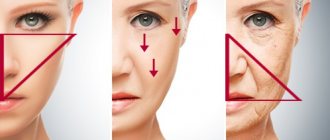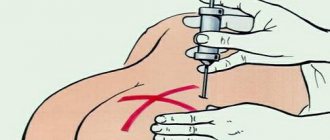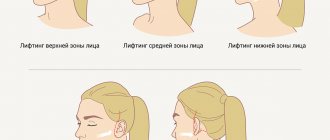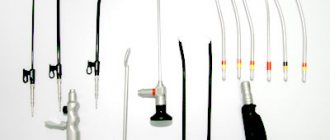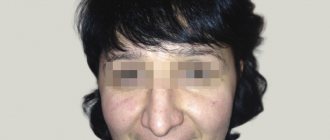- home
- Facial plastic surgery
- Plastic surgery, midface lift - indications and techniques
Facial aging depends on several factors: heredity, lifestyle (sleep, sun, cigarettes), self-care, general health, and also, to a large extent, weight stability. It is impossible to clearly determine when a patient will need facial plastic surgery. It makes no sense to focus on age in this matter, since the basis for the operation is objective medical indications and individual aesthetic requirements.
Endoscopic midface lift
The middle zone of the face, namely the eyes, eyelids, cheeks, is subject to age-related changes noticeably more than the lower one. These delicate tissues begin to age noticeably earlier: the cheeks sag, deep wrinkles appear, even folds, circles and recesses under the lower eyelids, the healthy and youthful volume of the face disappears. At the same time, its lower contour can remain good and relatively elastic. In such cases, plastic surgery offers endoscopic midface lifting - tightening the cheeks and muscles around the eyes and eyelids.
Photos "before" and "after"
Endoscopic lifting of the upper third of the face opens the eyes and creates the effect of blepharoplasty of the upper eyelids (but without stitches!). Surgeon: Iskornev Andrey.
The height of girls' eyebrows should correspond to the distance from the inner to the outer level of the eye. For men, eyebrows can be slightly lower than this calculation, but not fall over the eyelids. Surgeon: Iskornev Andrey.
Facial anatomy
In order to visualize and clearly understand what age-related changes can be eliminated with the help of a facelift, and what visible successes can be achieved, it would be good to know how our face is anatomically structured. What and for what reason happens to him over the years.
Facial tissues are represented by layers of skin, muscles and subcutaneous fat. All this covers the bones of the facial skeleton like a stretched rubber band. But everything in the world is subject to destruction and decline, our appearance is no exception. In the process of aging, once fresh, full of vital energy tissue weakens and stretches, the skin loses natural collagen, and with it elasticity, a wonderful ability to maintain young, dense contours.
There are completely objective reasons for the aging of facial tissues:
- Skin ages mainly due to sun exposure. Nothing has such a detrimental effect on the skin as the sun's rays - they destroy the network of collagen and elastin. By losing these important components, the skin loses its strength and flexibility, changes its structure and takes on a weakened, flabby appearance.
- The facial muscles, in turn, suffer the most from facial movements. Facial expressions, especially pronounced ones, stretch and weaken them.
- Time itself has the strongest effect on subcutaneous fat. The fat layer, which once gave our face soft, smooth outlines, is depleted and sinks down, pulling the skin along with it.
All these changes naturally occur in parallel. Due to this, the eyelids and cheeks droop, areas of depression appear under the eyes and in the area of the upper jaw, and deep wrinkles form in the middle zone of the face.
Restrictions
From the very first day of rehabilitation, the patient should remember the temporary rules and restrictions.
- Avoid sleeping on your stomach or side.
- Do not allow pressure or any mechanical impact to be applied to facial tissues.
- In the first days, while there is inflammation and swelling, it is better to refuse decorative and skincare cosmetics.
- Travel should be canceled during early rehabilitation.
- It is important to reduce any physical activity.
- Protect your facial skin from direct sun exposure.
- Do not steam your skin (for the same reason, hot baths, saunas, steam baths are not recommended).
What happens during a midface lift?
There are several types of face lifts in plastic surgery. Each of them is aimed at eliminating certain age-related changes in a given area. Usually the name of the procedure speaks for itself, and a midzone lift is aimed at rejuvenating the middle part of the face: the cheeks, lower eyelids, and the area around the mouth. It is important to understand that it does not affect the neck, chin or lower jaw contours. In addition, lifting will not affect the tone and texture of the skin in any way. These are separate, completely different operations, although they can accompany a midzone lift.
Age-related changes in the forehead, eyebrows, neck and chin, that is, the upper and lower areas of the face, are usually corrected with a forehead lift, as well as with traditional complex facial plastic surgery. Heaviness and weakness of the eyelids, bags under the eyes can be eliminated with the help of blepharoplasty - eyelid surgery.
What happens during midface lift surgery?
The muscles of the cheeks, lips and infraorbital areas are specially strengthened and raised, the fat pads in the cheeks are tightened - as a result of which the face regains its youthful volume and elastic shape, the proportions are restored to the original ones.
Under no circumstances should you make “I need a specific lift” decisions on your own. To understand what kind of lifting you need, which technique is most suitable in your particular case, and which additional procedure will give a greater rejuvenating effect, you need to consult a doctor.
At your appointment, the doctor will examine your face and determine the true causes of age-related changes. Because for each of us, aging occurs individually and unevenly. Even if it seems to you that, for example, a circular lift of the entire face is necessary, perhaps the weakening of a specific muscle is responsible for your specific changes. A weak cheek muscle, for example, can visually give the effect of drooping of the entire lower facial part. But in fact, in this case, only lifting the middle zone will be enough.
In short, a good professional, after examination, will clearly establish the specific reasons for the changes and choose the right approach, based on considerations of achieving the best aesthetic result with minimal surgical intervention.
How is the operation performed?
A midface lift is usually performed under general anesthesia. The operation takes about two hours. Age-related changes cause soft tissue to sag relative to the lower edge of the orbit, exposing its contour. Lower eyelid fat pads may begin to bulge to a certain extent, highlighting this transition. Below the fullness of the cheek loses volume and becomes flatter, the soft tissues of the midface and cheek area sag, droop and emphasize the apparent depth of the nasolabial fold. Together, this results in a smoother appearance of the cheek when viewed from a three-quarter perspective.
In addition, the convexity of the cheek, which in youth was a single unit, becomes a double convexity, consisting of a bony malar part and lowered soft tissue below. When viewed from the front, the shadow is concave between the two convexities described above. This shadow appears as dark circles under the eyes and can be described as a sign of fatigue, loss of vitality and aging.
- During a cheek lift, sagging tissue is vertically lifted into a more youthful position.
- Small incisions are made in the temporal areas and, as in lower blepharoplasty, just below the eyelashes.
- The soft tissues of the cheek-zygomatic region are mobilized, then tightening internal sutures are applied, which are fixed to the temporal fascia.
They dissolve within 6 months, and the tissues heal firmly in the new place. In this way, a long-term lifting effect of the middle third of the face is achieved.
Cheek Lift surgery also involves tightening the sagging lower eye muscle, providing support to the lower eyelid structure. A midface lift can be combined with a neck and face lift to completely rejuvenate the face and neck in a natural way. In addition, the procedure can be combined with other aesthetic surgeries such as a brow lift or upper eyelid surgery (blepharoplasty), if necessary.
⇒ INFORMATION: Causes of wrinkles and ways to eliminate them
Incisions in the scalp
Today, lifting the midface, eyes and eyelids can be performed using a variety of surgical techniques. Often, surgeons use access through the lower eyelids in mid-zone plastic surgery.
However, endoscopic technology occupies a leading place among other methods - it is the most convenient, modern and least traumatic for the patient. In addition, when used, there are practically no traces of surgical intervention.
During an endoscopy, the doctor makes tiny incisions in the part of the head that is covered by hair. An endoscope, a thin metal tube with a camera at the end, is inserted through the incisions under the tissue.
The image is displayed on the computer monitor. Thanks to this, this technique allows surgeons to see what is happening from the inside.
The surgeon’s goal is to move the facial tissues and fat layer higher, to lift them, as they are relaxed and stretched over time. To do this, the doctor uses very thin, blunt instruments to lift and peel away the tissue under the skin. As a result of these manipulations, a thin tunnel is created in the middle zone of the face, which allows you to tighten the sagging tissue from the inside.
Midface lift results
The first noticeable changes on your face can be seen immediately after removing the bandages. And after three weeks - a month, when the bruises and swelling disappear, the transformation will become even more noticeable. However, the final result of lifting will appear only four to five months after the intervention. It is this result that will be consolidated and last for several years.
It should be noted that the healing process is individual for each person. On some people, scars heal very quickly, on others it takes longer. In addition, you must understand that surgery is not a miracle and it will not slow down the inevitable process of further aging of the face.
However, there is no doubt that you will be satisfied with the aesthetic result - after all, the contours of the face after lifting the middle zone will tighten and become clearer, the sunken areas under the eyes and on the cheeks will disappear, the face will look fresher and younger. And the new image will delight you for many years to come!
How long do the results last?
The result is usually not even perceived as the result of the operation. People around him usually note that the patient looks cheerful or particularly well-rested, as if he had recently returned from vacation, without assuming that this is due to the operation.
The effect after the procedure is visible immediately, although its final version can be assessed after a few months, when the tissues adapt and swelling subsides.
Of course, over time, the effect of the operation will undergo changes due to the ongoing aging process and the influence of gravity. However, you will always look better than if you had not had the surgery. In 10 to 15 years, you may look the same as you did before surgery, but ultimately be younger than if you had not had it.
Preparing for surgery
At your doctor’s appointment, tell us not only about your wishes, but also about past illnesses, allergies, chronicles, and body characteristics (such as long-term wound healing, colloid scars). Don't forget to mention previous facial surgeries, if any.
A professional will examine your face, including the skin, muscles and bones of the skull. Prescribe the necessary tests and issue special instructions:
- If you smoke, you should quit smoking a few weeks before surgery.
- It is important to stop taking medications containing acetylsalicylic acid. In particular, aspirin. These medications thin the blood, which can have an extremely undesirable effect on the healing process.
- Alcohol should be limited a few days before surgery. It can also interfere with rapid tissue healing.
- On the day of surgery, you will most likely start taking antibacterial medications as prescribed by your doctor to prevent infections.
The midface lift operation itself lasts an hour to an hour and a half, no more. All manipulations are performed under general anesthesia.
Aesthetics of the orbital complex
Any aesthetic surgery on the face is preceded by an in-depth analysis, during which the plastic surgeon evaluates each facial structure individually and in its interaction with the others. When performing an endoscopic forehead lift, the aesthetics of the orbital complex is of no small importance, which the specialist analyzes during a face-to-face consultation with the patient.
The “classic” eyebrow should be located laterally and medially at the same horizontal and medial level. In women, as a rule, the brow arch has the peculiarity of arching above the edge of the orbit, while the male eyebrow has a horizontal contour. It should also be noted that there are differences in the level of location of the eyebrow arches: men’s eyebrows “lie” on the upper edge of the orbit, while women’s eyebrows are located much higher. The highest point of a woman's eyebrow should be at the level of the lateral canthus. This should be taken into account when performing endoscopy of the forehead, because a more medial rise of the brow ridge can create an unnatural, surprised appearance.
Alexander Grudko comments:
During the consultation, the patient closes his eyes and relaxes his forehead muscles for 15-20 seconds. Then I ask him to open his eyes and look straight ahead without raising his eyebrows. This gives me the opportunity to evaluate the eyebrow at rest. The second step is to assess the shape and position of the eyebrow in relation to the eye socket.
Recovery after midface surgery
No matter how carefully and professionally a midface lift is performed, it is still a serious surgical intervention. Therefore, you should be prepared for the fact that, as after any operation, you may be bothered by swelling, mild bruising and mild soreness for several days.
Bruising will disappear two weeks after the intervention. The swelling will become barely noticeable within a month, and will finally go away after a few months.
Sometimes special compression bandages are used to reduce post-operative swelling. They successfully provide tissue support and patient comfort.
In rare cases, during endoscopic lifting, special drainage tubes are used to drain the fluid. But they are removed on the second day after the operation. The stitches will be removed in a week to 10 days. In just two weeks you will be able to return to your usual household chores and work.
